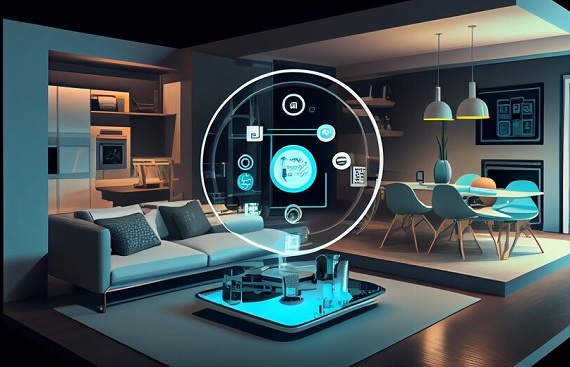Smart home technology is rapidly redefining “comfortable home,” going beyond simple convenience to significantly improve accessibility for seniors and those with mobility challenges. Home Mobility Pros provide expert guidance to navigate the various options available, helping residents achieve a safe, convenient and comfortable living environment. While much of the attention is on the latest smart home products and features, it's how these technologies are accessed and integrated into daily life that truly impacts users.
Improving Accessibility with Smart Home Technology
![]()
Smart homes play a key role in improving accessibility for homeowners with disabilities and allowing them to effectively manage their living spaces. What began as the home of the future became more of a reality as new products and technologies were introduced to the market. Today, the smart home is a tangible reality. The focus has shifted from highlighting the latest products and features to how users can utilize and integrate the advancements in their homes.
The smart home brings together sensors, household appliances, and communication networks that connect devices to enable remote monitoring, access, and control customized to the needs of the occupants. In recent years, there has been a significant increase in the availability of smart home appliances and devices designed for installation in the home, many of which feature embedded sensors or actuators. Sensors capture physical input from the environment and translate it into data that can be used by humans and machines, while actuators execute commands through mechanical action. Examples include smart lights, plugs, and locks that can remotely manage functions such as turning on/off or adjusting brightness, motion sensors that detect movement, thermostats that regulate the temperature in the home, air quality sensors that monitor indoor air quality, and kitchen appliances such as refrigerators and dishwashers that provide status updates and can control tasks such as detecting faults, adjusting temperature, and managing wash cycles.
Alok Hada, director, Anusha Technovision Pvt. Ltd., said, “Undoubtedly, one of the biggest challenges in building a smart home is the competing array of different platforms and standards. Smart home device manufacturers will increasingly need to ensure that their products and services are compatible with platforms offered by Amazon, Google, Samsung and Apple to capture the maximum target audience.”
Will robotics and automation improve home security?
![]()
Robotics and automation are transforming smart home security, enhancing threat monitoring, recognition, and response to make homes safer, more comfortable, and more tranquil. AI-driven robotic devices play a pivotal role, acting as vigilant sentinels that autonomously patrol and monitor the premises using advanced sensors and autonomous navigation, providing real-time data for immediate alerts and responses to minimize theft and vandalism. Automation complements these efforts by integrating various security functions through a central hub or smartphone app, allowing homeowners to efficiently control and manage their systems, create schedules, and simulate occupancy. This establishes a cohesive security ecosystem that dynamically responds to different scenarios. Robotics and automation make homes safer and more convenient. They enable remote access and use AI to learn occupant preferences, creating a safer and smarter living environment. Latest developments such as better AI algorithms and sensors enable robots to navigate more precisely and identify threats, improving home security.
Are smart homes the key to a sustainable future?
![]()
In today's world, tackling climate change and the depletion of natural resources has made sustainability a necessity. Innovative solutions for responsible resource use, especially the reduction of daily electricity consumption, are essential. Smart home technologies have emerged as a promising avenue that could revolutionize the way we manage and minimize energy consumption in our homes. To significantly improve energy efficiency and support sustainability, these systems must meet strict standards for energy management.
Smart home solutions often connect to Wi-Fi and are accessed through a smartphone app, tablet, or smart speaker. They include a variety of devices, such as door locks, TVs, thermostats, cameras, monitors, lighting fixtures, and home appliances such as refrigerators, washing machines, and vacuum cleaners. Users can change the schedule or control these devices using a mobile app or networked device. Managing energy use in the home is complex with a variety of power-consuming devices, from HVAC systems to lighting and electronics. Small oversights, such as leaving the lights on or forgetting to adjust the thermostat, can add up to significant energy waste. Smart home technology offers a solution by integrating devices that communicate and automate energy-saving tasks.
For example, smart thermostats learn user behavior to optimize temperature settings, while smart lights and plugs automatically turn off when not in use. In addition, these systems enable real-time energy monitoring and can incorporate renewable energy sources such as solar panels to reduce dependency on the power grid. The effectiveness of a smart home depends heavily on the quality of the devices and network, which requires rigorous development and testing to ensure reliability. By advancing and testing smart home technologies, Keysight plays a key role in efficiently conserving energy and fostering a sustainable future. With a variety of features, including appliances that respond to voice commands, advanced energy management systems and enhanced home security, the smart home is a symbol of modern living. Its convenience and enhanced security are highly attractive to consumers around the world.
Disclosure
As technology advances, smart homes in India are poised to leverage AI and machine learning to enable more intuitive living spaces. Despite challenges, the market is growing, driven by the demand for comfort, security, and energy efficiency. With the rollout of 5G and a growing population, the future of smart homes in India looks promising and will require continued innovation and quality to thrive.

